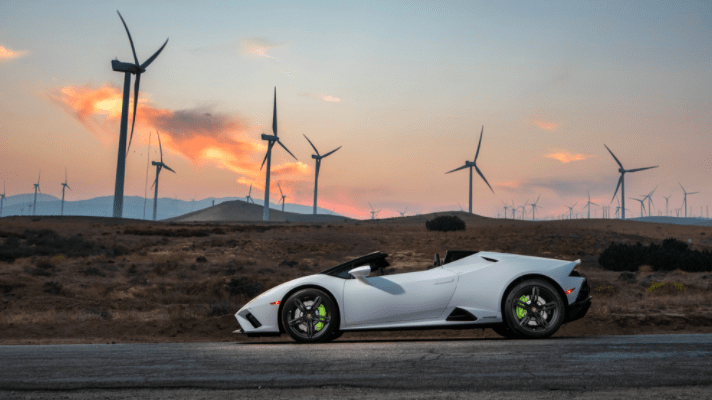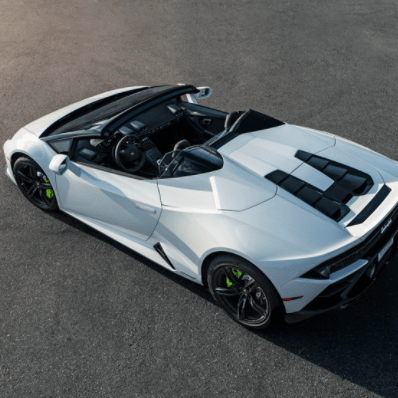Model: Lamborghini Huracán Evo RWD Spyder
Engine: 5.2-liter, naturally aspirated V-10
Power: 602 hp
Torque: 413 ft lbs
Transmission: Seven-speed LDF dual-clutch
Wheelbase: 103.15 inches
Dynasties are divisive. Whether in politics or sports, continued success usually breeds equal measures of admiration and criticism. (New England Patriots, anyone?) The Robb Report Car of the Year competition appears to have a contender for that role with Automobili Lamborghini. The difference, though, is that the majority of critics tend to be converted once they climb into the driver’s seat.
In recent years, models from the Sant’Agata Bolognese automaker have been a fixture at the top of our lists, placed there by judges who were not expecting even to like the car, let alone lavish praise on it. The latest disruptor: Lamborghini’s Huracán Evo RWD Spyder, the 2021 Robb Report Sports Car of the Year.
It’s no secret that, for a few decades, Lamborghinis were viewed by many as supercars for the uncouth—as loud, showy and temperamental as their owners. But that reputation has been greatly rehabilitated since the Volkswagen Group took control and brought the marque under Audi’s umbrella, ultimately creating automobiles that offer not just exclamatory performance, but a civil, even refined real-world driving experience.
The sea change for Lamborghini came in 2014 with the introduction of the Huracán coupe, followed by more noteworthy variants that include the Performante, with its innovative active aerodynamics, and the all-wheel-drive (AWD) Evo—for “Evolution”—equipped with a game-changing super processor that seems to know what you want to do a split-second before you do.
Referred to as Lamborghini Dinamica Veicolo Integrata (LDVI), the original AWD Evo’s leading-edge tech continuously analyzes the driver’s input against vehicle orientation, and prepares the other systems—including torque vectoring, traction control and suspension—in anticipation of the next move. The result is a car that allows a driver to push closer to his limit without crossing it. Sometimes, though, experienced drivers want to lengthen the leash, and that’s where the new rear-wheel-drive (RWD) Evo Spyder comes in.
The decision to offer a RWD version was easy, according to Alessandro Farmeschi, CEO of Lamborghini America. “We wanted to go back to the purest driving emotion,” he stated during a technical briefing on the car back in October, calling it an “unfiltered experience behind the wheel.”
That’s not to say that all the assists aren’t there if you need them—there’s just more room to cut loose. While the RWD configuration eliminates certain functionalities like torque vectoring, a new Performance Traction Control System (P-TCS) allows greater freedom to kick the back end loose and get your drift on.
In Sport (one of three modes, along with Strada and Corsa) the P-TCS lets the rear wheels slide as it monitors oversteer and adjusts torque accordingly, bolstering unregulated oversteer by 30 percent compared to RWD predecessors. It also provides torque while the car is transitioning out of the drift or coming out of a turn, to ensure better traction.
The efficacy of the P-TCS system was recently experienced firsthand at Willow Springs International Raceway in Rosamond, California. Coming out of turn four while in Sport mode, the back end broke loose unexpectedly. Based on my steering input, there was enough torque to carry me through the quick correction before my heart knew to accelerate. Fast forward to Central California’s wine country roads during Car of the Year; I alternated between Strada and Corsa and felt the car trace the corkscrew stretches between vineyards without a hint of wanting to stray outside the lines. It’s only ready to play when you are.
With an aluminum-and-carbon-fiber chassis covered by a body of aluminum and thermoplastic resin, the 3,062-pound (dry weight) convertible also inspires confidence through a host of aerodynamic improvements. Lamborghini’s chief technical officer, Maurizio Reggiani, mentioned during his portion of the briefing that the team “started working from the front bumper all through the underfloor of the car to the rear diffusor in order to create the perfect Venturi effect,” explaining that the revised air-flow management gives the car less drag and 73 percent more rear downforce than its AWD sibling. It all comes in handy given the 610 hp roadster, with a naturally aspirated V-10 mated to a seven-speed dual-clutch transmission, covers zero to 62 mph in 3.5 seconds and can reach a top speed of 201 mph.
Much like how our Luxury Car of the Year, the sumptuous Rolls-Royce Ghost, delivers unexpected power and performance, this Lambo startles with how comfortable the cockpit is. Sure, it’s missing lambswool rugs and open-pore paldao wood trim, but it pampers with its ergonomic layout, Human-Machine Interface (HMI) infotainment system and impressive wind protection when open-air touring.
As the Huracán line eventually comes to an end, who knows what automaker and model will next rise to prominence in our annual evaluation? For now, the Evo RWD Spyder is the closest combination of race car and daily driver that we’ve encountered, and the latest example of why the Raging Bull continues its reign.



